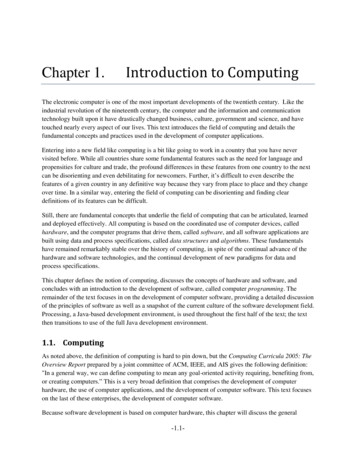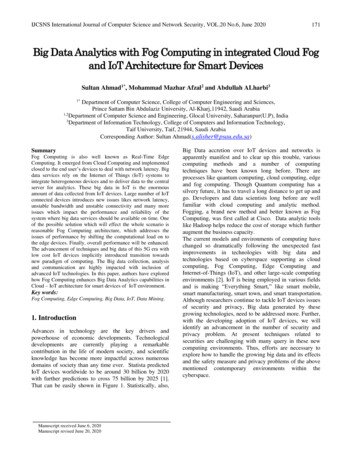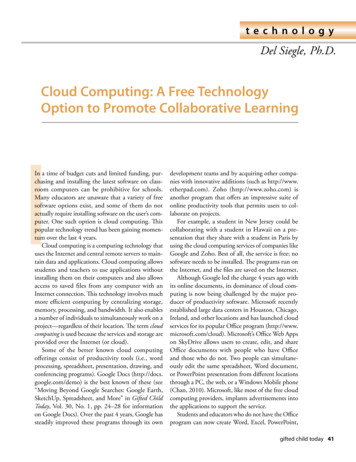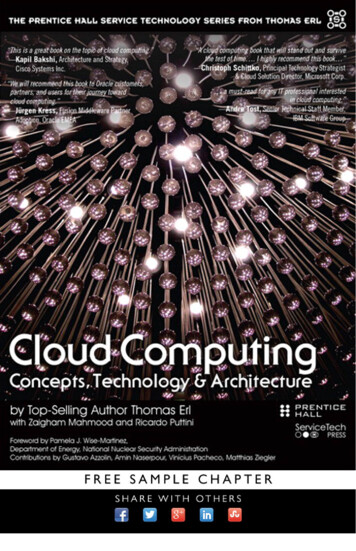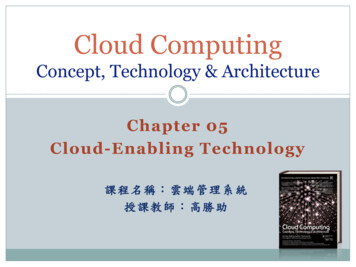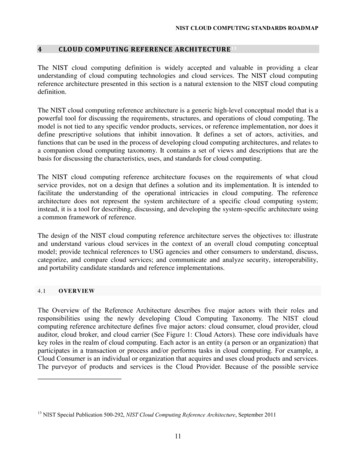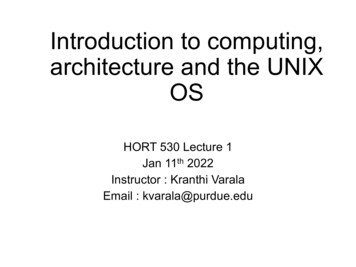
Transcription
Introduction to computing,architecture and the UNIXOSHORT 530 Lecture 1Jan 11th 2022Instructor : Kranthi VaralaEmail : kvarala@purdue.edu
Kranthi VaralaTwo roads diverged in a yellow wood,And sorry I could not travel bothAnd be one traveler–R. Frost
Introduction to Computing for Biology Class Times:vLecture: Tuesday 3:00 pm - 4:15 pm BRNG B282vLab: Thursday 3:30 pm - 5:20 pm Hicks G959 Lectures are in person, but also streamed on zoom Lab will be in person FOR NOW Zoom link sent via email 7 quizzes (70%), final project (30%) /IDAB/
Course goals Learning to use remote servers UNIX operating systemCommand-line toolsShell scriptingClusters and job management Learning programming Introduction to Python Learn to: Automate repetitive tasks Handle large data sets Link processes/tasks together (Serial & Parallel)
Lecture PlanWeek LectureLabTopicQuiz1211-Jan 13-Jan18-Jan 20-JanIntroduction to computing, architecture and the UNIX OSThe UNIX Operating System1325-Jan 27-JanDoing more in UNIX: Command-line tools241-FebRegular expressions: Text manipulation358-Feb 10-FebShell scripting and system variables615-Feb 17-FebSuper Computers, Job management, PBS4722-Feb 24-FebIntro to Programming, Variables and ObjectsIdea81-MarIntroduction to Python: Data types598-Mar 10-MarNumbers, strings, and lists1022-Mar 24-MarLists, conditions and loopsPseudocode1129-Mar 31-MarDictionaries, tuples and sets6Functions, Scope, Arguments7Version 1.03-Feb3-Mar125-Apr7-Apr1312-Apr 14-AprAlgorithms, Sorting1419-Apr 21-AprLibraries1526-Apr 28-AprNo LectureFinal project stages
Computer architecture: “How stuff works ” Almost everything you do on a computer passes through a seriesof components and is eventually broken down to individualcalculations/operations. The individual operations are performed on the CPU and theoutput is returned through another series of components to theuser. For example, clicking on a web link goes as follows: Mouse- USBport- Motherboard- CPU- Browser. Browser responds to thisclick in reverse: CPU- Motherboard- Graphics card- Monitor. Much of this complexity is hidden from the average user, butbecomes important when you are writing your own programs.
Hardware terminology CPU Central Processing UnitCore Complete subunit of CPUCPU 1 to Many coresRAM Memory Fast, temporary storageSecondary Storage (Disk) Slow, permanent storageBus Communication channel to move dataCache Very small, but very fast storageI/O Input and output devices or channelsBandwidth Size of data moved in 1 operation
Von Neumann ArchitectureImage Credit: Kapooht - Own work, CC BY-SA 3.0, https://commons.wikimedia.org/w/index.php?curid 25789639 This basic structure was first proposed by John Von Neumann in 1945.The Arithmetic/Logic Unit (ALU) does all the calculations.The Memory Unit (RAM) holds the program to be run and the data.The Control unit manages the flow of data and the execution of theprograms.
Data flows through bussesEg:Keyboard,Mouse, Harddrive,CD/DVD etc.BusBusEg:Monitor, Harddisk, Printer etc.BusImage Credit: Kapooht - Own work, CC BY-SA 3.0, https://commons.wikimedia.org/w/index.php?curid 25789639 A Bus is a dedicated channel for transmitting data from one componentto another. Busses vary in size and speed. The speed of information transfer through the various busses is a keylimitation on computational speed.
Harvard ArchitectureBusBusBusImage Credit: Nessa los - Own work, CC BY-SA 3.0, https://commons.wikimedia.org/w/index.php?curid 10303637 The main difference is that there are two separate busses for the dataand instructions (i.e., programs). These independent busses can then be different in size. For example,the data bus can be bigger than the instructions bus.
Caches improve CPU performance A cache is a small, temporary storage location directlyattached to the CPU. Modern CPUs are built with extremely fast caches toreduce the limitation caused by the need to move datathrough the busses. A cache can hold the data/instructions needed by theCPU for the next calculation(s) which reduces the timethe CPU has to wait for the next instruction AND data. The CPU, Memory and Storage devices have separatecaches. Multiple cores in a CPU share caches.
Modern CPU architectureImage Credit: https://www.embedded.com/print/4007065 Most modern computers use a hybrid architecture that is sometimescalled a modified Harvard architecture. Many of the modern gains in computing speed are a result of cacheoptimization and prediction of how data/instructions will be reused.
Examples of Hybrid architectureMainframeWorkstationPersonal Computer Computers come in a wide range of shapes and sizes. They still follow the same basic architecture. These computers differ vastly in their computational ability, portability anduser experience.Image Credit: 1. IBM, 2. Fujitsu 3. By Ashley Pomeroy - Own work, CC BY-SA 4.0, https://commons.wikimedia.org/w/index.php?curid 62729054
Examples of Hybrid architectureMainframeWorkstationPersonal ComputerDecreasing computational powerIncreasing portabilityIncreasing ease-of-useImage sources: 1. IBM2. omputer-2493287/3. 0523/sizes/o/in/photostream/
Hardware vs. Software Hardware is the physical component of a computer andincludes the CPU, Storage and I/O devices. Hard to changeand typically remains constant for the life of the machine. Software is the set of instructions that allows you to use thehardware. It includes the Operating System (OS), Devicedrivers, Applications etc. Easier to update, and is oftenpatched to improve function and/or security. Firmware is a specialized kind of software that is specific toand resides on the individual hardware components. May beupdated, but rarely does.
Operating Systems An Operating System (OS) serves as the middle layerbetween the hardware and the programs the userneeds. Examples of common operating systems are: UNIX,Windows, MacOS, Linux, Android, iOS etc. The common tasks of an OS include communicationwith hardware, memory management, storagemanagement, process/task management, networking,security, etc
Operating SystemsImage By Golftheman - Own work, CC BY-SA 3.0, https://commons.wikimedia.org/w/index.php?curid 4558519 Operating systems allow the separation of hardware management fromapplications/programs. For example, when an application reads or writes a file, the file accessand the writing functions are handled by the OS. This allows the applications to work across different hardware platforms,although the applications are still specific to the OS.
Operating SystemsLibraryVirtualMemoryImage By Golftheman https://commons.wikimedia.org/w/index.php?curid 4558519LibraryDeviceDriversFileServerKernel The Kernel is the core function of the OS and handles basic-levelcommunication between the various processes and the hardware. Specific modules such as the memory manager and device drivers alloweasier ways to update the OS as required. Libraries provide applications with standardized access to kernelfunctions.
Virtual Memory An abstract layer created andmanaged by the kernel. All memory requests fromapplications are sent to the Virtualmemory management process. Allows the applications to usephysically separate memorylocations as if they are continuous. Allows combining Memory chips(RAM) and Disk space into a singlememory space. Disk space configured for memoryuse is called “swap”. It is sloooow.12345Image Credit: Ehamberg - Own work, CC BY-SA 3.0, https://commons.wikimedia.org/w/index.php?curid 8352077
OS paradigms for user interaction Multiuser, shared access Examples: Clusters, Webclients, Browsers etc. Computational resourcesare managed by the OSand users may havedifferent levels of priority. User tasks are scheduledby the OS based onpriority. Single user, exclusiveaccess Examples: PCs,Smartphones etc. All resources arededicated to the singleactive user.
Client/Server paradigm A Server is a central, powerful machine that typically hasLOTS of computational power, memory and disk space. A client is a relatively smaller machine that connects to theserver and uses its computational power for specific tasks. Servers are optimized for speed and stability, but have verylimited User Interface (UI). Clients are optimized for ease-of-user and typically have agraphical UI. Clients and servers may have the same or different OS.They communicate through standardized communicationprotocols. Examples of communication protocols are: HTTP, FTP, SSHetc.
UNIX operating system First developed in 1970s, it is a multitasking OS thatsupports simultaneous use by multiple users. User interface is typically limited to text-only interactions,thus avoids wasting resources on generating graphics. It was built to simultaneously run thousands of programsand allow linking different programs together. Follows the Client/Server architecture where the UNIXserver supports multiple clients/users using acommunication protocol (eg., SSH).
UNIX operating system contd. UNIX OS has evolved to have numerous variants over thepast 50 years. The most commonly used variant of UNIX is called Linux(Named after its inventor Linus Torvalds). Linux itself comes in hundreds of varieties, calleddistributions, that all share the same kernel and differ in thelibraries and UI built on top of the kernel. MacOS and iOS is also based on a UNIX variant calledBSD. Android is also derived from Linux. Windows is the only major OS that is not based on UNIX.
UNIX access via Terminals Earliest clients, called terminals, that connected to UNIXservers were teletypewriters (TTY). Video capable terminals included a video screen and akeyboard (1970’s onward). Modern clients (i.e, your PC) uses a terminal emulator tomimic the behavior of a terminal. This terminal emulator establishes a connection to theserver to create a “shell”. A shell is a text interface that the users enter theircommands on. The server returns the output to the terminal. We will learn more about terminals and shells in the nextlecture.
Compute clusters Set of individual machines that are combined to worktogether and can be accessed as a single server. Each individual machine is called a node in the cluster. Aspecialized node called ”Head” node acts as the interactionpoint for users. A cluster OS manages the communication between nodesand the submission of user jobs to the appropriate nodes. Purdue hosts multiple clusters through the ResearchComputing facility (https://www.rcac.purdue.edu) You will all have accounts on the Scholar cluster for thiscourse.
Distributed Computing A grid of individual machines that areconfigured to contribute their idle time to runjobs for the central job server. Typically used when a large job can be brokendown into a set of small tasks that can be runindependently of each other. For example: Near-Earth Asteroid search,Protein folding, Rendering animation etc.
Virtual Machines VMs simulate a physical computer with its “hardware” and OSwithin another OS. Allows one server to provide multiple virtual machines. Allows one OS to emulate and run applications from another OS. Examples: VirtualBox, Vmware, Xen etc Image Credit: John ?curid 12351968
Cloud computing An extension of the virtualization concept, where the VM iscreated on-demand, on a remote server. Extensive customization of the VM is possible by specifyingthe “hardware” and the OS applications package on theVM. Numerous vendors offer cloud computing now, includingAmazon, Microsoft, Oracle and Google. For example, I can request a VM instance with the followingspecs: “12 cores, 128GB RAM, 1 TB Disk, Linux OS with aspecific list of libraries and applications”.
Architecture and OS Summary Be aware of the computer hardware you are working on. Pick the computing model best suited for your task, i.e., notevery task is well suited for a cluster. Moving data around, especially large biological datasets,can be ”expensive”. When you write programs, try to minimize the slow parts,such as reading/writing from disk. Optimize your programs to make best use of the serverarchitecture. Servers are meant to be shared. Be ”nice” by requestingonly the amount of resources you can use.
1 11-Jan13-Jan Introduction to computing, architecture and the UNIX OS 2 18-Jan20-Jan The UNIX Operating System 1 3 25-Jan27-Jan Doing more in UNIX: Command-line tools 2 4 1-Feb 3-Feb Regular expressions: Text manipulation 3 5 8-Feb10-Feb Shell scripting and system variab

